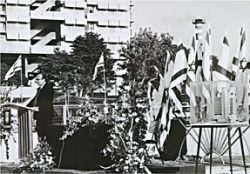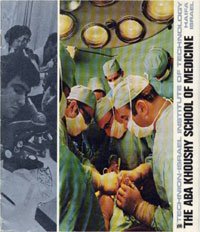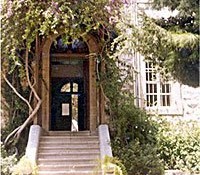The Faculty of Medicine was established in Haifa in 1969 by a group of physicians who  understood the importance of establishing a school for medical education and research in Northern Israel. The first class consisted of 43 students who completed their preclinical studies abroad. They were admitted to the faculty as fourth-year students and finished the requirements for the degree of Medical Doctor (M.D.), after two years of clinical training in Israeli hospitals.
understood the importance of establishing a school for medical education and research in Northern Israel. The first class consisted of 43 students who completed their preclinical studies abroad. They were admitted to the faculty as fourth-year students and finished the requirements for the degree of Medical Doctor (M.D.), after two years of clinical training in Israeli hospitals.
On January 3, 1971, the Senate of the Technion-Israel Institute of Technology approved a merger of the medical school with the Technion, to become fully effective by October 1, 1973. The academic backing of the Technion allowed the Faculty of Medicine to expand and to develop a comprehensive pre-clinical and clinical curriculum for a complete six-year medical education program. The first class to enter this six-year program was admitted in 1973.
The growing Faculty of Medicine needed permanent modern housing. The late Mr. Bruce Rappaport (1922-2010) and his wife Ruth, visionary and generous benefactors, provided substantial financial support and in June 1974, the cornerstone for a new spacious building was laid. Five years later, on October 30, 1979, the new medical faculty and research building was inaugurated. In June 1991, in recognition of the Rappaports’ continual support of the faculty, it was officially named the Ruth & Bruce Rappaport Faculty of Medicine.
 The Ruth & Bruce Rappaport Faculty of Medicine has expanded steadily since its establishment in 1969. New programs have been created, the student body has expanded and many new faculty members have been recruited. Since the first graduation in 1974, more than 2000 M.D. degrees have been awarded. The faculty includes a strong postgraduate school. Its MSc and PhD candidates are actively involved with faculty researchers in ongoing scientific and medical exploration
The Ruth & Bruce Rappaport Faculty of Medicine has expanded steadily since its establishment in 1969. New programs have been created, the student body has expanded and many new faculty members have been recruited. Since the first graduation in 1974, more than 2000 M.D. degrees have been awarded. The faculty includes a strong postgraduate school. Its MSc and PhD candidates are actively involved with faculty researchers in ongoing scientific and medical exploration
Special programs for outstanding students combining multidisciplinary education and research include MD/PhD and MD/Engineering programs and the MD/Law program in collaboration with the University of Haifa. The present Faculty body includes clinical scientists and clinical educators, approximately 350 technical and administrative personnel, 600 medical students and 200 graduate students.
The Ruth & Bruce Rappaport Faculty of Medicine is one of only a handful of faculties of medicine around the world that is part of a technological institute rather than a university. This unique position is most noticeable in the medical school curriculum. Throughout the program, quantitative and basic sciences are emphasized in order to upgrade in modern medical technologies. Collaborations between researchers in the Engineering Faculties and in the Faculty of Medicine are encouraged and often solicited in order to develop new technologies to deal with health problems of the 21st century.
Graduate students play an important role in excellence in research and education. A strong part of the educational program is the MD/ Ph.D. track for a very small number of outstanding students who have a major interest in biomedical research. One of the major research pillars of the Faculty of Medicine is the Rappaport Family Institute for Research in the Medical Sciences, which offers exceptional research opportunities in the rapidly progressing fields of molecular biology and biomedical sciences. The Faculty is proud of its distinguished members, Nobel Laureates (Chemistry, 2004) Avram Hershko and Aaron Ciechanover, as well as other world-renowned scientists.
 The missions of the Technion Faculty of Medicine do not end in research and teaching; they also include delivery of health care of the highest quality in northern Israel. Currently, eight medical centers are affiliated with the Faculty: Rambam Health Care Campus, Bnai Zion Medical Center and Carmel Medical Center in Haifa, HaEmek Medical Center in Afula, and Hillel Yafe Medical Center in Hadera ; two psychiatric hospitals Shaar Menashe Mental Health Center, Pardes Hana-Karkur and Tirat HaCarmel Mental Health Center, Haifa; 2 geriatric hospitals: Fliman Geriatric Center in Haifa and Shoham Medical Center for Geriatric Medicine. Plans are being made to expand activities and to affiliate more units from other medical centers to the Faculty and to strengthen the ties between the Faculty and the clinics of family practice that are spread throughout Northern Israel. We believe that academic affiliation of physicians in these health care units encourages clinical research and improved medical education and will attract more qualified professionals.
The missions of the Technion Faculty of Medicine do not end in research and teaching; they also include delivery of health care of the highest quality in northern Israel. Currently, eight medical centers are affiliated with the Faculty: Rambam Health Care Campus, Bnai Zion Medical Center and Carmel Medical Center in Haifa, HaEmek Medical Center in Afula, and Hillel Yafe Medical Center in Hadera ; two psychiatric hospitals Shaar Menashe Mental Health Center, Pardes Hana-Karkur and Tirat HaCarmel Mental Health Center, Haifa; 2 geriatric hospitals: Fliman Geriatric Center in Haifa and Shoham Medical Center for Geriatric Medicine. Plans are being made to expand activities and to affiliate more units from other medical centers to the Faculty and to strengthen the ties between the Faculty and the clinics of family practice that are spread throughout Northern Israel. We believe that academic affiliation of physicians in these health care units encourages clinical research and improved medical education and will attract more qualified professionals.
It is clear that medical education will continue to evolve to keep pace with continual new developments in medical sciences, genetic engineering, molecular biology and technology. At the same time, clinical education will continue to focus on important humanistic and ethical issues.